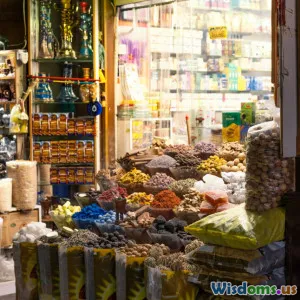
Culinary Adventures: Food Travel Tips
8 min read Explore essential food travel tips to savor global culinary delights and elevate your gastronomic adventures worldwide. (0 Reviews)
Culinary Adventures: Food Travel Tips
Traveling is often defined by the experiences that tantalize your senses, and nothing speaks louder than the local cuisine. Embarking on culinary adventures transforms an ordinary trip into an unforgettable journey filled with rich flavors, textures, and stories. But how do you ensure you get the best out of food travels without the pitfalls? This guide delivers practical, insightful food travel tips to help you navigate food landscapes with confidence and curiosity.
The Allure of Culinary Travel
Eating local isn't just about sustenance; it’s a window into the culture, history, and people of a destination. Anthony Bourdain famously said, "Food may not be the answer to world peace, but it’s a start." Culinary adventures allow travelers to experience authentic cultural expression through regional tastes and dining traditions.
Whether slurping noodles from a street vendor in Vietnam, savoring paella in Spain, or digging into freshly baked sourdough in San Francisco, each bite tells a story. However, food travel comes with challenges—from language barriers to dietary concerns—making preparation essential.
Research Before You Go: Know Your Destination’s Food Scene
One of the most vital steps before your culinary journey begins is research. Understanding the local food culture helps avoid tourist traps and reveals hidden gems.
Dive Into Local Specialties and Signature Dishes
Every destination boasts signature dishes, from Italy’s risotto alla Milanese to Morocco’s tagine. Studying these offers a roadmap to authentic eating rather than generic menus. Websites like Eater, Lonely Planet’s food guides, and locals’ blogs can provide invaluable insights.
For example, if traveling to Tokyo, prioritize exploring izakayas (traditional pubs) instead of just sushi chains frequently visited by tourists.
Language and Terminology
Learning basic food-related phrases and ingredient names can greatly enhance ordering experiences. Apps like Google Translate, and language tutors on platforms like Duolingo, can prepare you for marketplace haggling or restaurant interactions. For instance, knowing how to say "Are there nuts in this dish?" in the country’s language can be important for allergies.
Check Seasonal and Festival Foods
Food festivals highlight seasonal specialties and traditional preparations not available year-round. For example, Japan's cherry blossom (sakura) season features unique sakura-flavored treats. Timing your visit to such events enriches culinary profiles.
Navigating Street Food: An Essential Part of Culinary Exploration
Street food offers a thrilling way to immerse yourself in authentic cuisine without the formality of restaurants. However, hygiene might be a concern, and understanding how to pick safe and delicious options is key.
Safety Tips for Enjoying Street Food
- Observe the Crowd: Vendors with long lines usually indicate fresh, tasty, and safer food.
- Check Food Handling: Ensure vendors use gloves or utensils and prepare food fresh, not sitting exposed for hours.
- Start Small: Sample small portions to test how your stomach reacts before indulging further.
For instance, in Bangkok—renowned for its street food—popular stalls serving pad thai or mango sticky rice have an enormous local following, signifying reliability.
Trying Unexpected Dishes
Stepping out of your comfort zone can lead to exciting discoveries — such as trying escargot in France or durian fruit in Southeast Asia, famously dubbed the “king of fruits” but with a strong aroma that divides opinions.
Market Visits: Centers of Aroma, Texture, and Color
Local markets are treasure troves for food lovers and a fantastic way to observe culinary traditions in action.
Engage with Vendors
Ask about ingredients and preparation methods. Many vendors appreciate curiosity and might even share recipes or cooking tips.
Sample Fresh Produce and Homemade Goods
Farmers’ markets often offer organic fruits, vegetables, cheeses, and baked goods. In Tuscany, for example, markets brim with fresh truffles and olives that you won’t find easily elsewhere.
Participate in Food Tours
Joining guided food tours can augment market visits by introducing you to specialties you might overlook. Tours often combine history and cultural context which enrich the tasting experience.
Respect Dietary Restrictions and Sustainability
More travelers now prioritize health, sustainability, and ethical eating while abroad.
Communicate Dietary Needs Clearly
Carry cards in the local language explaining allergies or dietary restrictions. This reduces miscommunication and keeps your experience pleasant.
Support Sustainable Practices
Opt for farm-to-table eateries, support local farmers, and avoid over-consumption of endangered species. This conscious approach helps preserve gastronomic heritage and the environment.
Documenting Your Culinary Journey
Not only does recording your food experiences help remember favorite dishes, but it also allows sharing with friends or inspiring others.
Methods to Chronicle Your Adventures
- Food Journals: Notebook logs of what you ate, including taste notes and locations.
- Photography: Capturing food presentation plus surrounding ambiance.
- Blogs or Social Media: Platforms like Instagram offer excellent venues to engage food communities worldwide.
Top food travelers often share detailed insights; for example, Mark Wiens’ blog explores street food globally, providing descriptions and background that educate and inspire.
Conclusion: Embrace the Journey, One Bite at a Time
Culinary adventures are more than just meals—they are transformative experiences connecting you to cultures, people, and stories beyond the surface. By preparing thoughtfully with research, safety awareness, and an open mind, food travel can become the heart of your adventure.
Take risks, explore markets, savor street delicacies, and respect local customs for an enriching journey that satisfies far beyond your palate. As you embark on your next trip, let food be your compass, and discover the world through taste, one delicious bite at a time.
Bon appétit and happy travels!
Rate the Post
User Reviews
Other posts in Cultural Exploration
Popular Posts



















